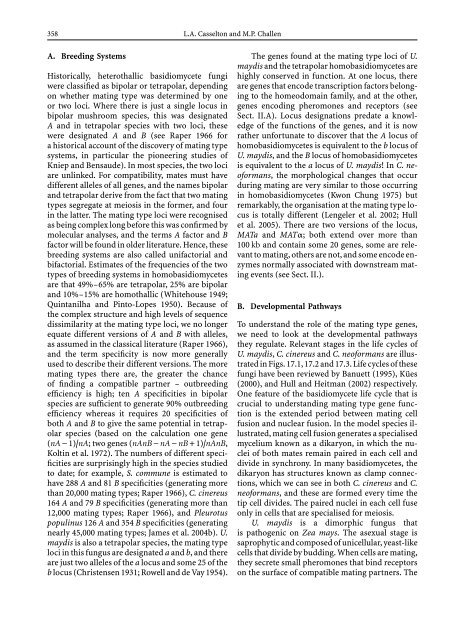Growth, Differentiation and Sexuality
Growth, Differentiation and Sexuality
Growth, Differentiation and Sexuality
You also want an ePaper? Increase the reach of your titles
YUMPU automatically turns print PDFs into web optimized ePapers that Google loves.
358 L.A. Casselton <strong>and</strong> M.P. Challen<br />
A. Breeding Systems<br />
Historically, heterothallic basidiomycete fungi<br />
were classified as bipolar or tetrapolar, depending<br />
on whether mating type was determined by one<br />
or two loci. Where there is just a single locus in<br />
bipolar mushroom species, this was designated<br />
A <strong>and</strong> in tetrapolar species with two loci, these<br />
were designated A <strong>and</strong> B (see Raper 1966 for<br />
a historical account of the discovery of mating type<br />
systems, in particular the pioneering studies of<br />
Kniep <strong>and</strong> Bensaude). In most species, the two loci<br />
are unlinked. For compatibility, mates must have<br />
different alleles of all genes, <strong>and</strong> the names bipolar<br />
<strong>and</strong> tetrapolar derive from the fact that two mating<br />
types segregate at meiosis in the former, <strong>and</strong> four<br />
inthelatter.Thematingtypelociwererecognised<br />
as being complex long before this was confirmed by<br />
molecular analyses, <strong>and</strong> the terms A factor <strong>and</strong> B<br />
factor will be found in older literature. Hence, these<br />
breeding systems are also called unifactorial <strong>and</strong><br />
bifactorial. Estimates of the frequencies of the two<br />
types of breeding systems in homobasidiomycetes<br />
are that 49%–65% are tetrapolar, 25% are bipolar<br />
<strong>and</strong> 10%–15% are homothallic (Whitehouse 1949;<br />
Quintanilha <strong>and</strong> Pinto-Lopes 1950). Because of<br />
the complex structure <strong>and</strong> high levels of sequence<br />
dissimilarity at the mating type loci, we no longer<br />
equate different versions of A <strong>and</strong> B with alleles,<br />
as assumed in the classical literature (Raper 1966),<br />
<strong>and</strong> the term specificity is now more generally<br />
used to describe their different versions. The more<br />
mating types there are, the greater the chance<br />
of finding a compatible partner – outbreeding<br />
efficiency is high; ten A specificities in bipolar<br />
species are sufficient to generate 90% outbreeding<br />
efficiency whereas it requires 20 specificities of<br />
both A <strong>and</strong> B to give the same potential in tetrapolar<br />
species (based on the calculation one gene<br />
(nA −1)|nA; two genes (nAnB − nA − nB +1)|nAnB,<br />
Koltin et al. 1972). The numbers of different specificities<br />
are surprisingly high in the species studied<br />
to date; for example, S. commune is estimated to<br />
have 288 A <strong>and</strong> 81 B specificities (generating more<br />
than 20,000 mating types; Raper 1966), C. cinereus<br />
164 A <strong>and</strong> 79 B specificities (generating more than<br />
12,000 mating types; Raper 1966), <strong>and</strong> Pleurotus<br />
populinus 126 A <strong>and</strong> 354 B specificities (generating<br />
nearly 45,000 mating types; James et al. 2004b). U.<br />
maydis is also a tetrapolar species, the mating type<br />
loci in this fungus are designated a <strong>and</strong> b, <strong>and</strong> there<br />
are just two alleles of the a locus <strong>and</strong> some 25 of the<br />
b locus (Christensen 1931; Rowell <strong>and</strong> de Vay 1954).<br />
The genes found at the mating type loci of U.<br />
maydis <strong>and</strong> the tetrapolar homobasidiomycetes are<br />
highly conserved in function. At one locus, there<br />
are genes that encode transcription factors belonging<br />
to the homeodomain family, <strong>and</strong> at the other,<br />
genes encoding pheromones <strong>and</strong> receptors (see<br />
Sect. II.A). Locus designations predate a knowledge<br />
of the functions of the genes, <strong>and</strong> it is now<br />
rather unfortunate to discover that the A locus of<br />
homobasidiomycetes is equivalent to the b locus of<br />
U. maydis, <strong>and</strong> the B locus of homobasidiomycetes<br />
is equivalent to the a locus of U. maydis! InC. neoformans,<br />
the morphological changes that occur<br />
during mating are very similar to those occurring<br />
in homobasidiomycetes (Kwon Chung 1975) but<br />
remarkably, the organisation at the mating type locus<br />
is totally different (Lengeler et al. 2002; Hull<br />
et al. 2005). There are two versions of the locus,<br />
MATa <strong>and</strong> MATα; both extend over more than<br />
100 kb <strong>and</strong> contain some 20 genes, some are relevant<br />
to mating, others are not, <strong>and</strong> some encode enzymes<br />
normally associated with downstream mating<br />
events (see Sect. II.).<br />
B. Developmental Pathways<br />
To underst<strong>and</strong> the role of the mating type genes,<br />
we need to look at the developmental pathways<br />
they regulate. Relevant stages in the life cycles of<br />
U. maydis, C. cinereus <strong>and</strong> C. neoformans are illustrated<br />
in Figs. 17.1, 17.2 <strong>and</strong> 17.3. Life cycles of these<br />
fungi have been reviewed by Banuett (1995), Kües<br />
(2000), <strong>and</strong> Hull <strong>and</strong> Heitman (2002) respectively.<br />
One feature of the basidiomycete life cycle that is<br />
crucial to underst<strong>and</strong>ing mating type gene function<br />
is the extended period between mating cell<br />
fusion <strong>and</strong> nuclear fusion. In the model species illustrated,<br />
mating cell fusion generates a specialised<br />
mycelium known as a dikaryon, in which the nuclei<br />
of both mates remain paired in each cell <strong>and</strong><br />
divide in synchrony. In many basidiomycetes, the<br />
dikaryon has structures known as clamp connections,<br />
which we can see in both C. cinereus <strong>and</strong> C.<br />
neoformans, <strong>and</strong> these are formed every time the<br />
tip cell divides. The paired nuclei in each cell fuse<br />
only in cells that are specialised for meiosis.<br />
U. maydis is a dimorphic fungus that<br />
is pathogenic on Zea mays. The asexual stage is<br />
saprophytic <strong>and</strong> composed of unicellular, yeast-like<br />
cells that divide by budding. When cells are mating,<br />
they secrete small pheromones that bind receptors<br />
on the surface of compatible mating partners. The

















